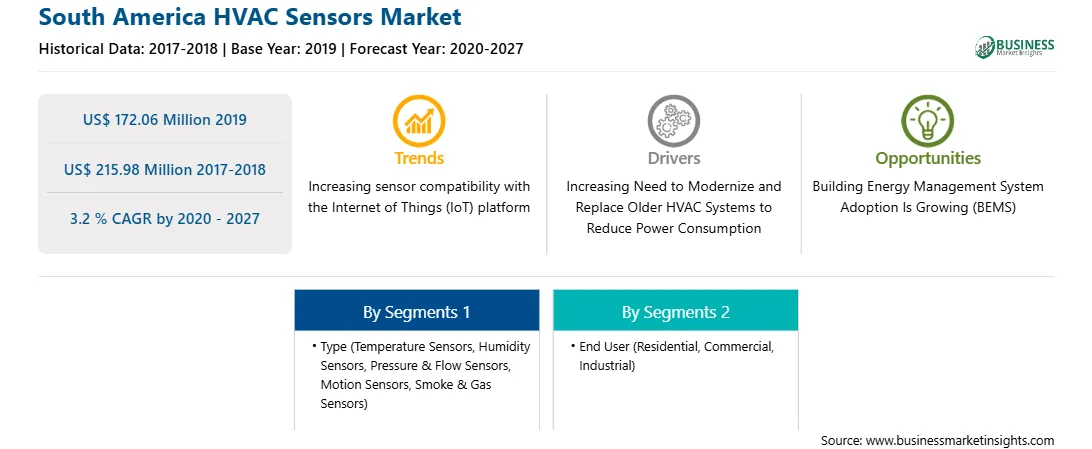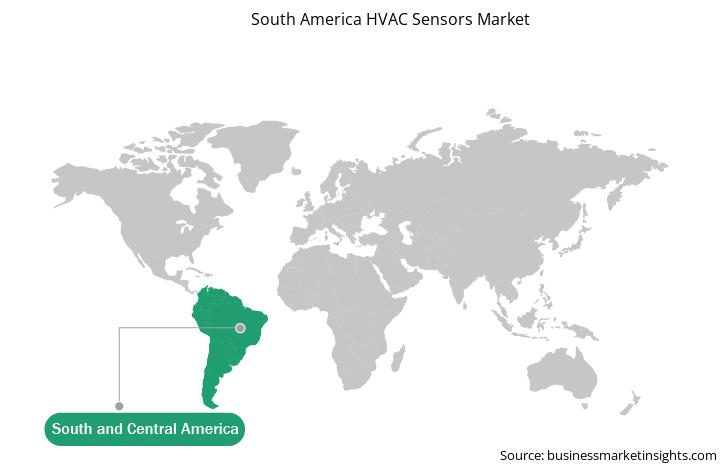The growing construction industry in the region with a rising number of residential and commercial places is driving the growth of the HVAC sensors market. Increasing demand for advanced HVAC systems to improve air quality in building has created a huge growth opportunity for the SAM HVAC sensors market. Brazil has a focus on energy-efficient HVAC applications with a specific perspective, while Argentina, Chile, and other countries are still lagging in adopting HVAC systems. Thus, the market has a considerable growth in the region as the adoption of HVAV systems is very limited or low. The increasing installation of air conditioning systems in Brazil is mounting the market growth. Moreover, growing construction activities in the region are supporting the market growth. For instance, in 2016, owing to the Olympic event the Brazilian government invested more than US$ 7.77 billion for the construction of new hotels, venues, and other infrastructure, which augmented the demand for HVAC systems. Further, advent of smart, connected, and energy efficient IOT-enabled HVAC systems and growing development of smart cities are the other factors driving the growth of the SAM HVAC sensors market.
Furthermore, in case of COVID-19, SAM is highly affected specially Brazil, which got the highest number of coronavirus cases, followed by Peru, Chile, Colombia, and Ecuador, among others. The emergence of COVID-19 virus across SAM region has created enormous disruption across industries including electronics and semiconductors. Every phase of the business model has been witnessing drastic change, including the manufacturing units, capital expenditures, R&D, demand, supply-chain, production decisions, and mergers and acquisitions (M&A). Before COVID-19 outbreak, SAM countries have been witnessing growth in number of industries over the past few years. Industries such as automotive, aerospace, and industrial equipment have been experiencing fair growth rate; however, the COVID-19 outbreak has created significant turmoil among the manufacturers across industries. The government of SAM has taken an array of actions to protect their citizens and contain COVID-19’s spread. Brazil has the largest industrial sector and is also the worst-hit country. This has been highlighting limited resources and investments toward product developments, which has slow-downed the adoption of HVAC systems and HVAC sensors. This factor has negatively impacted the SAM HVAC sensors market.

Strategic insights for the South America HVAC Sensors provides data-driven analysis of the industry landscape, including current trends, key players, and regional nuances. These insights offer actionable recommendations, enabling readers to differentiate themselves from competitors by identifying untapped segments or developing unique value propositions. Leveraging data analytics, these insights help industry players anticipate the market shifts, whether investors, manufacturers, or other stakeholders. A future-oriented perspective is essential, helping stakeholders anticipate market shifts and position themselves for long-term success in this dynamic region. Ultimately, effective strategic insights empower readers to make informed decisions that drive profitability and achieve their business objectives within the market.

| Report Attribute | Details |
|---|---|
| Market size in 2019 | US$ 172.06 Million |
| Market Size by 2027 | US$ 215.98 Million |
| Global CAGR (2020 - 2027) | 3.2 % |
| Historical Data | 2017-2018 |
| Forecast period | 2020-2027 |
| Segments Covered |
By Type
|
| Regions and Countries Covered | South and Central America
|
| Market leaders and key company profiles |
The geographic scope of the South America HVAC Sensors refers to the specific areas in which a business operates and competes. Understanding local distinctions, such as diverse consumer preferences (e.g., demand for specific plug types or battery backup durations), varying economic conditions, and regulatory environments, is crucial for tailoring strategies to specific markets. Businesses can expand their reach by identifying underserved areas or adapting their offerings to meet local demands. A clear market focus allows for more effective resource allocation, targeted marketing campaigns, and better positioning against local competitors, ultimately driving growth in those targeted areas.

The SAM HVAC sensors market is expected to grow from US$ 172.06 million in 2019 to US$ 215.98 million by 2027; it is estimated to grow at a CAGR of 3.2 % from 2020 to 2027. Escalating demand for HVAC sensors in the automotive sector is expected to upsurge the SAM HVAC sensors market. Rising number of annual automotive sales is considered a significant factor contributing to the growth of the SAM HAVC sensors market. Requirement for automatic as well as well-regulated air-conditioning in automobiles is constantly growing. As the sensor systems used in automobiles are becoming more complex in design and functionalities, the demand for high-quality economical sensors is increasing. Additionally, governments in several countries are implementing regulations concerning emission control, which is influencing the demand for temperature sensors. The advancement in HVAC sensors used in automobiles enables zone-wise climate control and provides protection from external harmful gases and odor. Pressure sensors, temperature sensors, and air quality sensors are among the advanced sensors used to perform these actions. Moreover, the automotive manufacturers are making constant efforts to further improve the vehicle comfort concerning climate. For instance, the integration of Carbon-dioxide (CO2) sensors in automotive HVAC systems is one of the significant developments in the automotive HVAC systems. These developments coupled with rising automotive sales are propelling the growth of the SAM HVAC sensors market.
In terms of type, the temperature sensors segment accounted for the largest share of the SAM HVAC sensors market in 2019. In terms of end user, the commercial segment held a larger market share of the SAM HVAC sensors market in 2019.
A few major primary and secondary sources referred to for preparing this report on the SAM HVAC sensors market are company websites, annual reports, financial reports, national government documents, and statistical database, among others. Major companies listed in the report are BELIMO AIRCONTROLS (USA), INC.; Emerson Electric Co.; Honeywell International Inc.; Johnson Controls, Inc.; Schneider Electric; Sensata Technologies, Inc.; Sensirion AG; Siemens AG; TE Connectivity Ltd.
The South America HVAC Sensors Market is valued at US$ 172.06 Million in 2019, it is projected to reach US$ 215.98 Million by 2027.
As per our report South America HVAC Sensors Market, the market size is valued at US$ 172.06 Million in 2019, projecting it to reach US$ 215.98 Million by 2027. This translates to a CAGR of approximately 3.2 % during the forecast period.
The South America HVAC Sensors Market report typically cover these key segments-
The historic period, base year, and forecast period can vary slightly depending on the specific market research report. However, for the South America HVAC Sensors Market report:
The South America HVAC Sensors Market is populated by several key players, each contributing to its growth and innovation. Some of the major players include:
The South America HVAC Sensors Market report is valuable for diverse stakeholders, including:
Essentially, anyone involved in or considering involvement in the South America HVAC Sensors Market value chain can benefit from the information contained in a comprehensive market report.